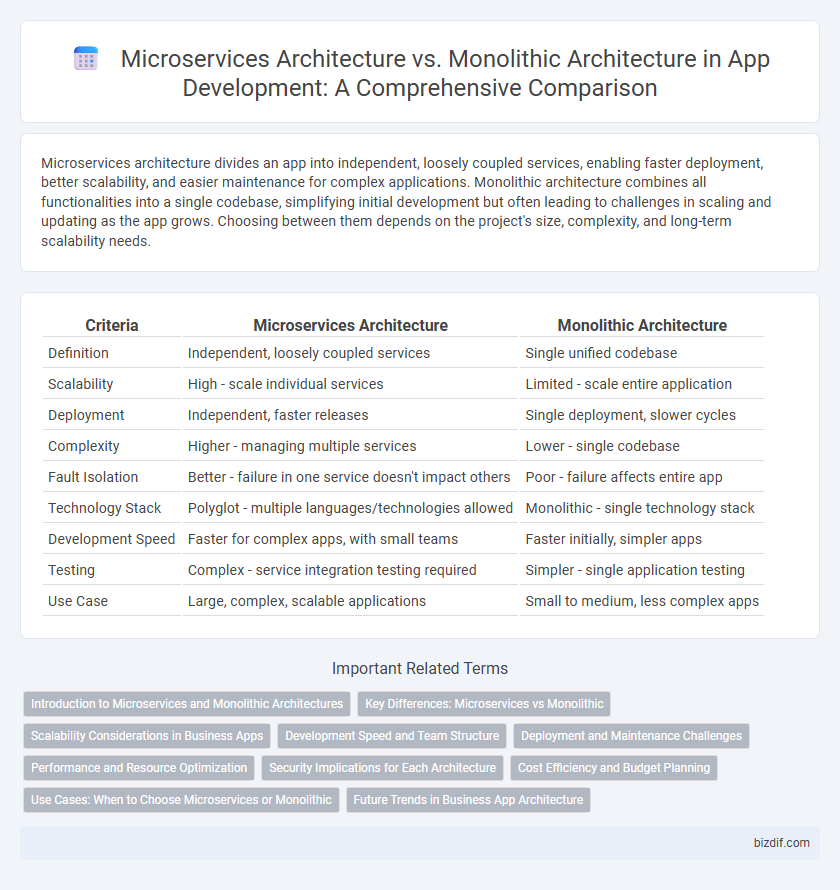Microservices architecture divides an app into independent, loosely coupled services, enabling faster deployment, better scalability, and easier maintenance for complex applications. Monolithic architecture combines all functionalities into a single codebase, simplifying initial development but often leading to challenges in scaling and updating as the app grows. Choosing between them depends on the project's size, complexity, and long-term scalability needs.
Table of Comparison
| Criteria | Microservices Architecture | Monolithic Architecture |
|---|---|---|
| Definition | Independent, loosely coupled services | Single unified codebase |
| Scalability | High - scale individual services | Limited - scale entire application |
| Deployment | Independent, faster releases | Single deployment, slower cycles |
| Complexity | Higher - managing multiple services | Lower - single codebase |
| Fault Isolation | Better - failure in one service doesn't impact others | Poor - failure affects entire app |
| Technology Stack | Polyglot - multiple languages/technologies allowed | Monolithic - single technology stack |
| Development Speed | Faster for complex apps, with small teams | Faster initially, simpler apps |
| Testing | Complex - service integration testing required | Simpler - single application testing |
| Use Case | Large, complex, scalable applications | Small to medium, less complex apps |
Introduction to Microservices and Monolithic Architectures
Microservices architecture structures an application as a collection of loosely coupled services that communicate over network protocols, enabling independent deployment, scalability, and technological diversity. Monolithic architecture consolidates all functions into a single codebase and deployment unit, simplifying development but limiting flexibility and scalability. Choosing between microservices and monolithic designs depends on factors such as team size, application complexity, deployment frequency, and scalability requirements.
Key Differences: Microservices vs Monolithic
Microservices architecture divides applications into loosely coupled, independently deployable services, enhancing scalability and fault isolation compared to monolithic architecture, which centralizes all functions within a single codebase. Monolithic systems simplify development with unified deployment but often face challenges in scaling, updating, and maintaining complex applications. The granular nature of microservices allows for diverse technology stacks and continuous delivery, while monoliths typically require comprehensive testing and redeployment for any code changes.
Scalability Considerations in Business Apps
Microservices architecture enables independent scaling of individual services, enhancing flexibility and resource efficiency in business apps, whereas monolithic architecture requires scaling the entire application, often leading to higher costs and slower response to demand changes. The distributed nature of microservices supports easier implementation of load balancing and fault isolation, critical for maintaining performance during traffic spikes. Monolithic systems may struggle with scalability due to tightly coupled components, limiting rapid adjustments necessary for dynamic business environments.
Development Speed and Team Structure
Microservices architecture enhances development speed by enabling independent teams to work on distinct services simultaneously, accelerating feature delivery and reducing bottlenecks. In contrast, monolithic architecture often requires coordinated efforts across the entire codebase, slowing down development cycles and complicating team collaboration. Small, cross-functional teams thrive in microservices environments, while monolithic structures typically demand larger, more hierarchical teams to manage tightly coupled components.
Deployment and Maintenance Challenges
Microservices architecture enables independent deployment of services, reducing downtime and accelerating bug fixes, while monolithic architecture requires redeploying the entire application for updates, increasing downtime risks. Maintenance in microservices demands managing multiple service versions and inter-service communication, which can complicate debugging and monitoring compared to the simpler, unified codebase of monolithic systems. Scalability in microservices is more flexible, allowing targeted resource allocation per service, whereas monolithic applications often face challenges scaling the entire application uniformly.
Performance and Resource Optimization
Microservices architecture enhances performance by enabling independent scaling of services, reducing resource wastage compared to monolithic systems that allocate resources uniformly regardless of demand. It allows for optimized resource utilization through isolated deployment and targeted load balancing, improving response times and fault isolation. In contrast, monolithic architecture often suffers from performance bottlenecks and inefficient resource use due to its tightly coupled components and single deployment unit.
Security Implications for Each Architecture
Microservices architecture enhances security by isolating services, reducing the attack surface, and limiting the blast radius of breaches, but it requires robust API security, inter-service authentication, and comprehensive monitoring to prevent vulnerabilities. Monolithic architecture centralizes the codebase, simplifying security management with unified access controls, but a single breach can compromise the entire application due to tightly coupled components. Effective security in microservices demands advanced strategies like identity and access management (IAM) and service mesh implementation, whereas monolithic security relies heavily on securing perimeter defenses and application-level controls.
Cost Efficiency and Budget Planning
Microservices architecture enables cost efficiency by allowing teams to develop, deploy, and scale individual components independently, reducing resource wastage and optimizing cloud infrastructure expenses. In contrast, monolithic architecture often results in higher upfront costs and complicated budget planning due to its tightly coupled components and difficulty in scaling. Choosing microservices supports granular budgeting and flexible resource allocation, ultimately lowering total cost of ownership in app development projects.
Use Cases: When to Choose Microservices or Monolithic
Microservices architecture suits complex, large-scale applications requiring scalability, independent deployment, and fault isolation, such as e-commerce platforms and real-time analytics. Monolithic architecture is ideal for simple, small to medium-sized projects with straightforward workflows, like MVPs or internal tools, where rapid development and ease of testing are priorities. Choosing microservices enhances flexibility and resilience in distributed environments, while monolithic simplifies development and deployment cycles when system boundaries are clear.
Future Trends in Business App Architecture
Microservices architecture dominates future business app development due to its scalability, flexibility, and ease of continuous deployment, allowing companies to innovate rapidly and respond to market changes. Monolithic architecture, while simpler to develop initially, struggles with scalability and maintenance as applications grow, making it less suitable for modern cloud-native environments that prioritize modularity and resilience. Emerging trends emphasize containerization, serverless computing, and AI-driven orchestration in microservices, enabling businesses to build adaptive, high-performance applications optimized for dynamic workloads.
Microservices architecture vs Monolithic architecture Infographic

 bizdif.com
bizdif.com